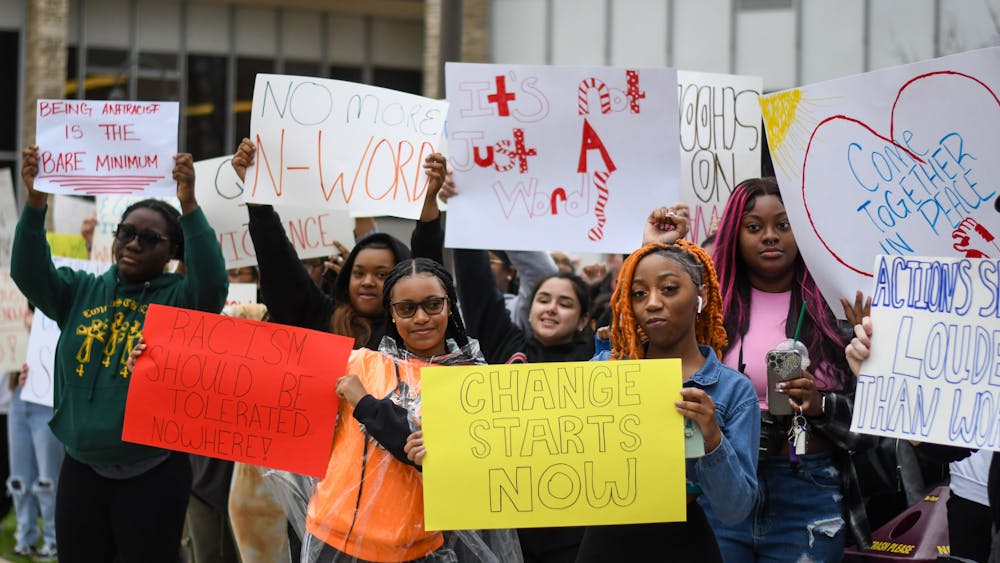Challenge Yourself, Challenge the World
Students become 'active, global citizens' on Winter Alternative Breaks
Andrea Ramirez grew up 14 miles outside of Saginaw, the city she considers home. She was exposed to the issue of poverty at an early age. As a middle schooler, Ramirez volunteered at food pantries.
She wanted to make a difference.
“I know it’s the same issue everywhere, just a different location,” Ramirez said. “I can see what it does to people around me.”
The Reese senior heard about Alternative Breaks at Central Michigan University, a volunteer program that allows students to pick a social issue they care about, and then travel to a destination to serve communities coping with that problem.
During her sophomore year, Ramirez was put on a waitlist. The next year, she and her roommates got up before the 7:30 a.m. sign-up time, and eagerly awaited news of their appointments.
It worked. That year each of was chosen to participate in an Alternative Break.
Last semester, Ramirez chose to volunteer and became one of the 228 students shipped off on Alternative Breaks across the nation. These students sacrificed spending time with their families at the start of winter break. Some even slept on floors, or on cots in dusty churches.
Along the way, they built new families and experiences with other students on Alternative Breaks.
This year the program, sponsored by the Mary Ellen Brandell Volunteer Center, sent 19 groups to 17 different locations at the end of the fall 2016 semester until Dec. 23.
Since its inception in 1994, the Alternative Breaks program at CMU has grown in recognition as a powerful force for good, helping students battle issues of poverty, hunger and other public crises.
CMU is ranked third for the amount of Alternative Breaks it offers and fourth for number of students who are a part of the program, according to Break Away, a national organization which provides resources to alternative break programs across the country.
Imlay City junior Chloe Kosinski was mentored at the Leadership Institute on campus her freshman year when she learned of the Alternative Breaks program.
Kosinski told herself she would go on an alternative break every year. She has traveled to Pittsburgh, Washington D.C. and went to Omaha, Nebraska this winter for a Criminal Justice Alternative Break.
”You’re broadening your horizons just by being here so you should take the opportunity,” Kosinski said. “There’s really no other time where you’re able to travel to a different state with random people and get to know them.”
The CMU Alternative Breaks program included 696 students in the 2015-16 academic year, with 49 breaks throughout the calendar year.
There were nearly 20 CMU students who visited Kentucky in 1994 on the first Alternative Break, which was started as a result of basic student interest, said graduate assistant Jennifer Drevon.
Now, the program offers week-long breaks in the winter, spring and summer, as well as weekend and international breaks.
Erica Johnson, assistant director of the Volunteer Center, said she hopes to have more than 700 students this year serving as “active global citizens” in the communities seeking student help.
Johnson said winter sign-ups on OrgSync filled within 90 seconds. Students are not given a location when they sign up, but pick an issue they care about. Once issues are filled, destinations are assigned.
“I think students know they’re positive experiences,” Johnson said. “There’s a lot of learning that happens on (Alternative Breaks), they’re a lot of fun and (students) are doing some good things. I really feel (our) students care about doing good.”
For students involved in Alternative Breaks, the lessons they learn are as unique and as rich as the places they visit. Their stories are ones of personal development, imbuing them with skills that affect real change.
Jonesboro, Arkansas
This year, Ramirez chose “Rural Poverty” as her issue, advancing from a participant to a site leader. A site leader is in charge of managing a budget, safety, travel and activities, as well as coordinating with community partners and leading the group. Site leaders receive $100 off their trip.
Site leaders are trained by the Student Advisory Committee, which is made up of 23 members and is led by Brooklyn senior Nick Aniol. He said the group coordinates sites, Enterprise vans for travel and budgets for each alternative break. The committee also selects the organizations the groups will encounter and strives to find long-term partnerships, Johnson said.
Ramirez’s group traveled to Jonesboro, Arkansas where the Food Bank of Northeast Arkansas supplied canned goods to the group. Ramirez, along with fellow site leader Aloysia Streeter and 10 participants, took a van down to Arkansas at midnight on Sunday, Dec. 18.
Each box provided by the food bank contained 15 cans for distribution to families in need. Ramirez said the biggest challenge was counting all the items correctly.
The group packed almost 900 boxes in one day, amounting to at least 1,100 meals for local families. When they became fatigued, program coordinator Erin King encouraged them to keep boxing.
Ramirez and the others kept pushing, creating competitions to boost morale, such as trying to fit 48 boxes on a single pallet.
“It brought us closer together because we’re all pretty competitive,” she said. “It was really uplifting.”

“I would have been fine sleeping on the floor,” she said. “Nobody complained at all.”
For one week, the group carried with them nothing but camaraderie. They didn’t wear fancy clothes or waste time playing on devices like iPhones or tablets. Instead, they stayed up late talking at midnight on the trip down south, stopping to eating burgers at Skinny J’s.
Ramirez said this was her final Alternative Break, but said she still talks to people from her Aurora trip.
“You become like a family with these people,” she said.
Charleston, South Carolina
Grand Rapids junior Jessica Rowland is attending CMU in hopes that she’ll be a teacher one day. Her interest in helping children drove her to choose “Youth Advocacy” as her issue.
Rowland and her group departed on Dec. 16 and stayed at a Methodist church outside of downtown Charleston. The students volunteered at the Carolina Youth Development Center and served programs such as Big Brothers, Big Sisters.
Residents at the center are typically foster-care children or those awaiting placement in foster care, Rowland said. She added that some children were there for a month, while other children waited for two years to be paired with a foster family.
Rowland and her group had a week to make an impact. The students’ main task was wrapping Christmas gifts for their residents. On the first day, Rowland said they wrapped gifts from 9 a.m. to 4 p.m.
The group felt tired and stressed at times, she said. They tried to wrap footballs, but they were too oddly shaped. Basketballs were too round. It was difficult.
They tried to lighten the mood. The group played holiday music, and got to know each other. Soon the boring and repetitive tasks became fun.
Rowland said they wrapped up more than 500 gifts for kids at the center. She was floored by how many gifts were donated.
“It was really eye-opening to see how much the community wanted to donate, to see how good of a Christmas these kids were going to have,” she said. “Even if they didn’t have families, they had support of the community (in Charleston).”
ne of the more moving aspects of the trip involved interacting with residents, Rowland said. One boy introduced everyone in his group as brothers. If a child wanted a pair of boots or a new game, Rowland and the group knew they would be receiving it.
On the last day, a brother-sister pair were sent off to a foster home with their new foster mother, Sara Perry, CYDC associate vice president of development.
Watching the creation of a brand new family, Rowland and her Alternative Break family celebrated with them.
Asheville, North Carolina
Just north of Rowland, Canton senior Cullan McNamara was leading a break group whose issue was “Access to Sports and Recreation.” They partnered with the YMCA of Western North Carolina.
McNamara played football and wrestled in high school and is involved with intramural sports at CMU. He said he cares about nutrition and health, especially in today’s world where children may be inactive.
The best part about the break was the variety of activities, McNamara said. The group helped with landscaping and built a pit for gaga ball, which is a type of dodgeball that the children were fond of. They helped clean out a stream and played sports with the kids.
They also helped distribute food. McNamara said this was the first year the YMCA distributed Christmas turkeys. The group surprised families who came to pick up produce with the bird.

“They said, ‘thank you for caring about us’ — which is just a crazy moment to think about,” McNamara said. “They were just so appreciative we were there, coming from Michigan, just to help them get that. It was an amazing moment.”
McNamara was a participant for his first alternative break, but decided to be a site leader for this trip — his final one. While he said there is a lot of work to do as a site leader, the feeling you get on a break can’t be recreated, and you leave with 11 new best friends.
“You don’t get to know people in the meetings beforehand but once you get in the van, you just really connect,” McNamara said. “(We played) road games — some people were searching for license plates, some people played card games. When you’re stuck with each other, you start to have good conversations about who you are and what you’re excited for with the trip.”
Kissimmee, Florida
Grand Rapids junior Payton Shatney has a passion for helping children. Her issue of “Uplifting Children and Families” brought her to central Florida.
Shatney and her group volunteered at the Give Kids the World Village, a place where the Make-A-Wish Foundation sends children with life-threatening illnesses to stay while they attend Walt Disney World, SeaWorld or Universal Studios.
The village itself is a resort with villas, food and carnival rides. The resort runs solely on volunteers, which Shatney said includes 2,000 hours of volunteer work each week.
“It brings a lot of people who are retired in to give them something to do and it gives them life,” Shatney said. “A lot of them were talking about how much joy it brings them to be around kids again.”

While Shatney was working in the castle one day, a girl walked in with her grandmother. In 2008, facing a life-threatening illness, she stayed at the resort and placed her star on the ceiling. She returned eight years later to find it.
Management was called and before long, they helped locate her star. Her grandmother began to cry. The girl, who was battling a life-threatening illness in 2008, returned eight years later to find her star.
Shatney said it was a moment of “pure joy.”
“It brought the whole experience full circle,” Shatney said. “It was incredible to see what the village brought them in 2008 and how it’s still bringing them joy in 2016. That was one of my biggest ‘wow, this is awesome’ moments.”
Getting Involved
Prior to leaving, there are eight group meetings which discuss issue education with a partner within the community they are traveling to, and how to be a good volunteer within the community. The groups also prepare their own meals in preparation for a minimalistic lifestyle.
Johnson said trips can cost up to $300, but the winter break season ranged from no cost to $176 due to fundraising efforts and travel grants. Travel, meals, lodging and service fees are some of the costs students are expected to cover.
Aniol said Max & Emily’s Eatery provides cheesecakes and Coyer Candle Co. in Midland offers candles for participants to sell. Can drives and a midnight skate aid the finances.
In addition, CMU pays about 25 percent of the cost for the breaks.
“We’re always looking to the future to see what we can do to meet student demand and see we’re providing quality experiences which are well thought-out and making sure the student leaders who advise the alternative breaks program alongside the university are making good choices on how we can move forward best for the students,” Drevon said.
Only 40 percent of alternative breaks programs across the country are student-led — a small portion CMU is in, Johnson said. When someone at CMU mentions “AB,” Johnson wants to associate that with a quality experience.
“I hope it means students care about learning how to make this world a better place,” she said. “I have high hopes for the future of our world and how current college students today are going to make that happen.”
Alternative Summer Break signups are slated for 7:30 a.m. on Monday, Jan. 30 on OrgSync
Aniol was looking for something to get involved in his freshman year. He visited the Volunteer Center to learn about different programs.
Six alternative breaks later, he is the leader of the program’s Student Advisory Committee. The program has a saying on the back of its T-shirts this year: “Challenge Yourself, Challenge the World.”
“It’s the idea you’re going out and learning all these things and bringing that back, and taking what you’ve learned and challenging the way the world is,” Aniol said.




